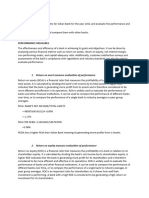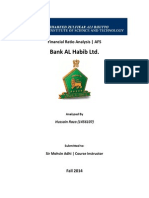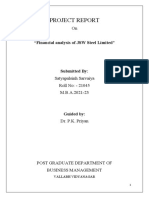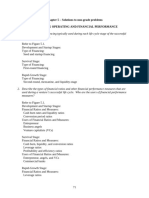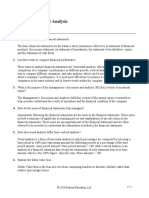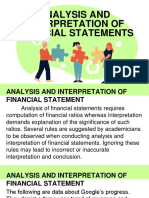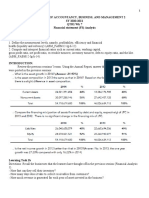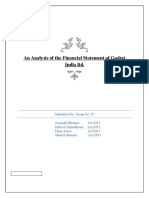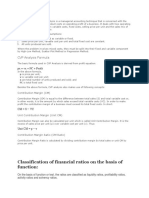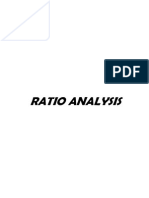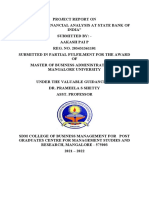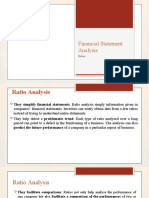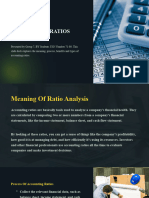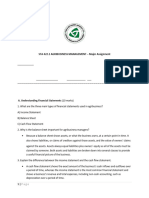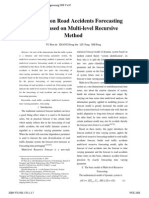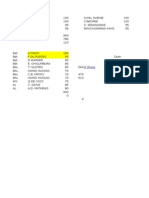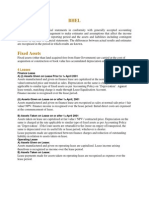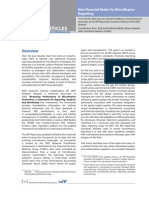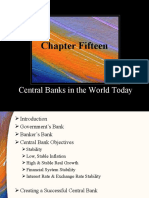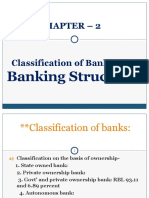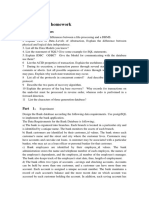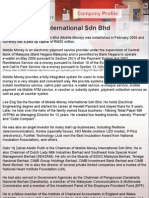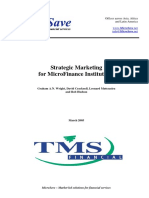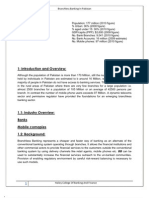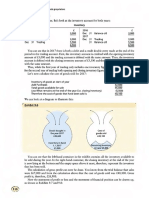Financial Ratio Analysis of Central Bank Submitted by Zuhaib Sherwani, 222/2014
Financial Ratio Analysis of Central Bank Submitted by Zuhaib Sherwani, 222/2014
Uploaded by
Abhishek JainCopyright:
Available Formats
Financial Ratio Analysis of Central Bank Submitted by Zuhaib Sherwani, 222/2014
Financial Ratio Analysis of Central Bank Submitted by Zuhaib Sherwani, 222/2014
Uploaded by
Abhishek JainOriginal Description:
Original Title
Copyright
Available Formats
Share this document
Did you find this document useful?
Is this content inappropriate?
Copyright:
Available Formats
Financial Ratio Analysis of Central Bank Submitted by Zuhaib Sherwani, 222/2014
Financial Ratio Analysis of Central Bank Submitted by Zuhaib Sherwani, 222/2014
Uploaded by
Abhishek JainCopyright:
Available Formats
Financial Ratio Analysis of Central Bank
Submitted by Zuhaib Sherwani, 222/2014
Introduction
Quantitative analysis of information contained in a companys financial statements. Ratio
analysis is based on line items in financial statements like the balance sheet, income
statement and cash flow statement; the ratios of one item or a combination of items - to
another item or combination are then calculated. Ratio analysis is used to evaluate various
aspects of a companys operating and financial performance such as its efficiency, liquidity,
profitability and solvency.
The trend of these ratios over time is studied to check whether they are improving or
deteriorating. Ratios are also compared across different companies in the same sector to see
how they stack up, and to get an idea of comparative valuations. Ratio analysis is a
cornerstone of fundamental analysis.
Ratio analysis can provide an early warning of a potential improvement or deterioration in a
companys financial situation or performance. Analysts engage in extensive number
crunching of the financial data in a companys quarterly financial reports for any such hints.
PERFORMANCE HIGHLIGHTS- Q1 FY 2015-16
Total Business of the Bank increased to Rs. 4,51,739 crore from Rs. 4,26,829 crore in
June 2014, recording Y-o-Y growth of 5.84 %.
Total Deposits of the Bank increased to Rs. 2,58,607 crore from Rs. 2,40,782 crore in
June 2014, recording Y-o-Y growth of 7.40 %.
Total Advances stood at Rs. 1,93,132 crore against Rs. 1,86,047 crore in June 2014,
recording Y-o-Y growth of 3.81 %.
CASA increased to Rs. 88,623 crore from Rs. 79,476 crore in June 2014, recording Yo-Y growth of 11.51 % .
Share of CASA in total deposits stood at 34.27 % as against 33.01 % in June 2014.
Core Deposits increased to Rs. 2,37,572 crore from Rs. 1,88,981 crore in June 2014,
recording Y-o-Y growth of 25.71 %.
Total Income increased to Rs. 7,099 crore from Rs. 6,928 crore in June 2014
recording Y-o-Y growth of 2.47 % .
Provision Coverage Ratio has improved from 51.52 % to 54.95 % on Y-o-Y basis.
CRAR under BASEL II is at 11.67 % with Tier I at 8.34 % whereas CRAR under
BASEL III is 10.84 % with Tier I at 8.03 %. NIM stood at 2.74% for the quarter
ended June 2015.
Zuhaib Sherwani
PGDM-Finance
222
Page 1
Financial Ratio Analysis of Central Bank
Submitted by Zuhaib Sherwani, 222/2014
Average Cost of Deposits
The interest rate paid by financial institutions for the funds that they deploy in their business.
The cost of funds is one of the most important input costs for a financial institution, since a
lower cost will generate better returns when the funds are deployed in the form of short-term
and long-term loans to borrowers. The spread between the cost of funds and the interest rate
charged to borrowers represents one of the main sources of profit for most financial
institutions.
=
Interest Paid
100
Average Deposits
2015
= 19,199.65/2,55,941.60 =7.50%
2014
= 17,963.08/2,40,344.53=7.47%
Average Cost of Deposits is well within industry benchmark, since a lower cost will generate
better returns when the funds are deployed in the form of short-term and long-term loans to
borrowers.
Average Yield on Advances
The average yield on an investment or a portfolio that results from adding all interest,
dividends or other income generated from the investment, divided by the average of the
investments for the year. The average annual yield is a particularly useful tool for floatingrate investments, in which the fund's balance and/or the interest rate change frequently.
= Interest Received on Advances 100
Average Advances
2015
= 26,475.98/1,89,067.53=14%
Zuhaib Sherwani
PGDM-Finance
222
Page 2
Financial Ratio Analysis of Central Bank
Submitted by Zuhaib Sherwani, 222/2014
2014
= 24,478.32/1,77,754.61=13.77%
Average Yield is 14% in year 2015 which is higher than 2014, bank is improving its advances
structure and getting better return
Net Interest Margin
A performance metric that examines how successful a firm's investment decisions are
compared to its debt situations. A negative value denotes that the firm did not make an
optimal decision, because interest expenses were greater than the amount of returns generated
by investments.
= Interest Received Interest Paid 100
Average Invested Assets
2015
= 26,475.98-19,199.65/95,655.36=7.6%
2014
= 24,478.32-17,963.08/86,262.40= 7.5%
A negative ratio means that the company is paying more in interest than its generating. For
banks and rental companies, this means the company would be better off using its assets to
pay off its loans than attempting to loan them out. For these same companies, any positive
ratio is better than a negative one, but a higher ratio represents a more effective use of assets.
Gross NPA Ratio
Gross NPA is the amount outstanding in the borrower account, in books of the bank other
than the interest which has been recorded and not debited to the borrower account.
=
Gross NPAs 100
Total Loans and Advances
2015
= 11,449/1,89,067.53=6.055%
Zuhaib Sherwani
PGDM-Finance
222
Page 3
Financial Ratio Analysis of Central Bank
Submitted by Zuhaib Sherwani, 222/2014
2014
= 12931/1,77,754.61=7.2%
Gross NPAs have fallen, NPAs are one of the concern area for a bank and they have able to
reduce their NPAs which is a good sign.
Net NPA Ratio
Gross NPA (Balance in Interest Suspense account + DICGC/ECGC claims received and
held pending adjustment + Part payment received and kept in suspense account + Total
provisions held).
=
Net NPAs
100
Total Loans and Advances
2015
=7448 /1,89,067.53=3.93%
2014
= 6,505/1,77,754.61=3.65%
The key challenge going forward for Indian banks is to expand credit portfolio and
effectively manage NPAs while maintaining profitability. Asset quality continues to be the
core function and also biggest challenge for the banks in the present dynamic environment.
Though, management of asset quality is a balance sheet issue of individual banks, it has
wider macro-economic implications. In order to overcome the associated risks including
externalities, there is an imminent need for the banks to have well-structured and effective
credit monitoring system in place coupled with appropriate business models.
Return on Average Assets
An indicator of how profitable a company is relative to its total assets. ROA gives an idea as
to how efficient management is at using its assets to generate earnings.
Zuhaib Sherwani
PGDM-Finance
222
Page 4
Financial Ratio Analysis of Central Bank
Submitted by Zuhaib Sherwani, 222/2014
=
Net Income 100
Total Average Assets
2015
= 618.3/3,10,951.65=.001988%
2014
= -1,251.51/2,88,254.53=-.00434%
ROA tells you what earnings were generated from invested capital (assets). ROA for public
companies can vary substantially and will be highly dependent on the industry. This is why
when using ROA as a comparative measure, it is best to compare it against a company's
previous ROA numbers or the ROA of a similar company. In 2015, ROA has decreased as
compared to 2014
Return on Equity
The amount of net income returned as a percentage of shareholders equity. Return on equity
measures a corporation's profitability by revealing how much profit a company generates
with the money shareholders have invested.
Net Income
100
Shareholders Equity
2015
= 618.3/1,658.27=3.72%
2014
= -1,251.51/1,350.44=-.92%
In other words, the return on equity ratio shows how much profit each rupee of common
stockholders' equity generates.
Zuhaib Sherwani
PGDM-Finance
222
Page 5
Financial Ratio Analysis of Central Bank
Submitted by Zuhaib Sherwani, 222/2014
So a return on 1 means that every rupee of common stockholders' equity generates 1 rupee of
net income. This is an important measurement for potential investors because they want to
see how efficiently a company will use their money to generate net income. Return on equity
has increased in 2015, Management is utilizing its resources more efficiently.
Operating Profit Ratio
The profit earned from a firm's normal core business operations. This value does not include
any profit earned from the firm's investments (such as earnings from firms in which the
company has partial interest) and the effects of interest and taxes.
=
Operating Expenses
Non Interest Income plus Interest Spread
2015
=5,596.64/26,475.98=21.11%
2014
=5,190.08/24,478.32=21.2%
It is a measure of income that tells investors how much of revenue will eventually become
profit for a company.
It is well with industry benchmark and core business of bank is performing well
Cost To Income Ratio
=
Operating Expenses
Net Interest Income + Non Interest Income
2015
= 5,596.64/28,376.37=19.72%
2014
= 5,190.08/26,409.70=19.65%
Zuhaib Sherwani
PGDM-Finance
222
Page 6
Financial Ratio Analysis of Central Bank
Submitted by Zuhaib Sherwani, 222/2014
CASA Ratio
This ratio of a bank is the ratio of deposits in current and saving accounts to total deposits
= Current Deposits +Savings Deposits
Total Deposits
2015
=13,238+ 75,385/2,58,607=34.26%
2014
=12,332+67,144 /2,40,782=33.01%
CASA Ratio has marginally increased in 2015 because while total deposits have increased
substantially, CASA deposits have increased only by a large amount.
Interest Expense Ratio
A ratio used to determine how easily a company can pay interest on outstanding debt. The
interest coverage ratio is calculated by dividing a company's earnings before interest and
taxes (EBIT) of one period by the company's interest expenses of the same period:
= Interest Expense
Interest Income
2015
= 26,475.98/ 19,199.65= 1.38 Times
2014
= 24,478.32/ 17,963.08= 1.36 Times
Zuhaib Sherwani
PGDM-Finance
222
Page 7
Financial Ratio Analysis of Central Bank
Submitted by Zuhaib Sherwani, 222/2014
Camel Ratios
CAMEL are an acronym for six measures Capital Adequacy, Assets Quality, Management
Soundness, Earnings, Liquidity, and Sensitivity to market risk. In this analysis the six
indicators which reflect the soundness of the institution framework are considered.
The six factors examined are as follows:
C - Capital adequacy
A - Asset quality
M - Management quality
E - Earnings
L - Liquidity
Capital Adequacy Ratio
Capital adequacy ratios (CARs) are a measure of the amount of a bank's core capital
expressed as a percentage of its risk-weighted asset and it is also known as "Capital to Risk
Weighted Assets Ratio (CRAR)
= Tier 1 Capital + Tier 2 Capital
Risk Weighted Assets
2015
= 8.34
2014
= 8.46
Zuhaib Sherwani
PGDM-Finance
222
Page 8
Financial Ratio Analysis of Central Bank
Submitted by Zuhaib Sherwani, 222/2014
Total debt/shareholders equity
2015
= 2,82,040.19/15,920.81=17.71
2014
= 2,62,481.08/14,170.08=18.52
Financial Leverage = Total assets/shareholders equity
2015
=3,10,951.65 /15,920.81=19.53
2014
=2,88,254.53 /14,170.08=20.34
Capital formation rate = Retained net income/ average shareholders equity
2015
=14,262.54/15,045.45=.947
2014
=11,202.64/13,920.47=.804
Asset Quality
Loans/Total Assets
2015
= 26,098.59/ 3,10,951.65= 0.083931344
2014
= 22,136.55/ 2,88,254.53= 0.07679515
A rise in the ratio in the current year indicates a better utilization of the assets by the bank.
Zuhaib Sherwani
PGDM-Finance
222
Page 9
Financial Ratio Analysis of Central Bank
Submitted by Zuhaib Sherwani, 222/2014
NPA/Total loans
2015
= 11,449/ 3,10,951.65= 0.0368
2014
= 12931/ 2,88,254.53= 0.0448
Reserve for NPA/NPA
2015
= 5625,24/11,449/ = 0.49133
2014
=42155.506/12931/ = 0.326
Interest earning assets/ Total assets
2015
= 2,82,040.19/3,10,951.66= 0.907
2014
=2,62,481.08/2,88,254.53 = 0.911
Non-interest earning assets/total assets
2015
= 1-0.907=.093
2014
=1-0.911=.089
Management Competence
Zuhaib Sherwani
PGDM-Finance
222
Page 10
Financial Ratio Analysis of Central Bank
Submitted by Zuhaib Sherwani, 222/2014
Credit Deposit Ratio - It is the ratio of how much a bank lends out of the deposits it has
mobilized. It indicates how much of a bank's core funds are being used for lending, the main
banking activity. A higher ratio indicates more reliance on deposits for lending and viceversa.
=
Total Advances
100
Customer Deposits
2015
= 1,93,132/33,470=577.03%
2014
= 1,86,047 / 28545 = 651.76%
Clearly the total advances to customer deposits are rising for the bank.
Earnings Ability
Return on Average Assets
An indicator of how profitable a company is relative to its total assets. ROA gives an idea as
to how efficient management is at using its assets to generate earnings.
Net Income 100
Total Average Assets
2015
= 618.3/3,10,951.65=.001988%
2014
= -1,251.51/2,88,254.53=-.00434%
ROA tells you what earnings were generated from invested capital (assets). ROA for public
companies can vary substantially and will be highly dependent on the industry. This is why
when using ROA as a comparative measure, it is best to compare it against a company's
Zuhaib Sherwani
PGDM-Finance
222
Page 11
Financial Ratio Analysis of Central Bank
Submitted by Zuhaib Sherwani, 222/2014
previous ROA numbers or the ROA of a similar company. In 2015, ROA has decreased as
compared to 2014
Return on Equity
The amount of net income returned as a percentage of shareholders equity. Return on equity
measures a corporation's profitability by revealing how much profit a company generates
with the money shareholders have invested.
Net Income
=
100
Shareholders Equity
2015
= 618.3/1,658.27=3.72%
2014
= -1,251.51/1,350.44=-.92%
In other words, the return on equity ratio shows how much profit each rupee of common
stockholders' equity generates.
So a return on 1 means that every rupee of common stockholders' equity generates 1 rupee of
net income. This is an important measurement for potential investors because they want to
see how efficiently a company will use their money to generate net income. Return on equity
has increased in 2015, Management is utilizing its resources more efficiently.
Interest income/ Average interest earning assets
2015
= 28376.37/2,84,722.89= 0.099663115
2014
= 26409.7/2,64,017.01 = 0.100030297
Net Profit Ratio
=
Net Profit 100
Zuhaib Sherwani
PGDM-Finance
222
Page 12
Financial Ratio Analysis of Central Bank
Submitted by Zuhaib Sherwani, 222/2014
Total Income
2015
= 618.3 /28,376.37= 2.178%
2014
= -1,251.51/26,409.70 = 4.73%
Net profit Ratio in the current year has increased marginally because of the increase in net
profits.
Efficiency ratio= Non-interest expense/(Net income + Fee commissions)
2015
= 8,558.42/ 2,518.69= 3.39
2014
= 9,698.12 /679.87 = 14.2
Breakeven point= (total expenses non-interest income)/Total average interest earning assets
2015
= 25,857.68/666.06 = 38.2
2014
= 25,729.82/-1,213.22= -21.2
Dividend Per Share
Dividend per share indicates the return earned per share. It is bit different from return on
equity capital. It is calculated by dividing dividend on equity share capital by the total
number of equity shares. It is a good measure of profitability and when compared with
DPS similar other banks, it gives a view of the comparative earnings or earning power of
a bank
= Dividend on Equity Share Capital
Number of Equity Shares
Zuhaib Sherwani
PGDM-Finance
222
Page 13
Financial Ratio Analysis of Central Bank
Submitted by Zuhaib Sherwani, 222/2014
2015
= 16492770 / 18142047 = Rs. 0.909
2014
= 13134876 / 18388826.4 = Rs. 0.714
Liquidity Ratios
Current Ratio - Current ratio may be defined as the relationship between current assets and
current liabilities. Current assets include cash in hand, balance with RBI, balance with other
banks (both in India and abroad), money at call and short notice and stock. Current liabilities
include short-term borrowings, short-term deposits, bills payables, bank overdraft and
outstanding expenses. It is a measure of general liquidity and it is widely used to make the
analysis of a short-term financial position or liquidity of a bank. It is calculated by dividing
the total current assets by total current liabilities
(1) Loans/Deposits
2015
= 26,098.59/ 2,55,941.60= 0.10197
2014
= 22,136.55/ 2,40,344.53= 0.09210
Current Ratio for the bank has fallen in FY 2015 as the fall in the current liabilities is
proportionally smaller than the fall in the current assets.
(2) Liquid assets/deposits
2015
= 2,99,560.91/2,55,941.60=1.170426808
2014
= 2,76,403.33/2,40,344.53=1.150029626
(3)Liquid assets/(Deposits + Borrowings)
Zuhaib Sherwani
PGDM-Finance
222
Page 14
Financial Ratio Analysis of Central Bank
Submitted by Zuhaib Sherwani, 222/2014
2015
= 2,99,560.91/2,82,040.19=1.062121359
2014
= 2,76,403.33/2,62,481.08=1.053040966
Zuhaib Sherwani
PGDM-Finance
222
Page 15
You might also like
- International Certificate in Wealth and Investment Management Ed3Document685 pagesInternational Certificate in Wealth and Investment Management Ed3Sivaprasad Thekke Parayil80% (15)
- Sarah Finance Project 6th SemesterDocument24 pagesSarah Finance Project 6th Semestersarah IsharatNo ratings yet
- Synopsis of Financial Analysis of Indian Overseas BankDocument8 pagesSynopsis of Financial Analysis of Indian Overseas BankAmit MishraNo ratings yet
- EasyJet CompanyDocument21 pagesEasyJet CompanyHassan ZaryabNo ratings yet
- Reasons For Collapse of BanksDocument25 pagesReasons For Collapse of BanksMichael VuhaNo ratings yet
- Analyzing Financial Performance of ABAY Banks in Ethiopia: CAMEL ApproachDocument6 pagesAnalyzing Financial Performance of ABAY Banks in Ethiopia: CAMEL ApproachAshebirNo ratings yet
- Assessing Financial Health (Part-A)Document17 pagesAssessing Financial Health (Part-A)kohacNo ratings yet
- Term Paper - Accounting and FinanceDocument3 pagesTerm Paper - Accounting and FinanceJayNo ratings yet
- 5.2 Financial StudyDocument5 pages5.2 Financial StudyRon MagnoNo ratings yet
- NMIMS PGDBM Assignment Financial Accounting and Analysis Sem2 June 2019Document7 pagesNMIMS PGDBM Assignment Financial Accounting and Analysis Sem2 June 2019rajnishatpecNo ratings yet
- Financial AnalysisDocument14 pagesFinancial AnalysisTusharNo ratings yet
- Ratio AnalysisDocument2 pagesRatio AnalysisxealousNo ratings yet
- Nilutpul SirDocument11 pagesNilutpul SirTarekNo ratings yet
- Performance Measures: 1. Return On Asset Measure Evaluation of PerformanceDocument4 pagesPerformance Measures: 1. Return On Asset Measure Evaluation of PerformanceMohamed LibanNo ratings yet
- Analisis Laporan Keuangan - PT Unilever Indonesia Tbk.Document7 pagesAnalisis Laporan Keuangan - PT Unilever Indonesia Tbk.Fara Laynds Lamborghini100% (4)
- Financial: StatementDocument31 pagesFinancial: StatementGrace Joy100% (1)
- Session 2 - by Catherine Rose Tumbali - PPTDocument25 pagesSession 2 - by Catherine Rose Tumbali - PPTCathy TumbaliNo ratings yet
- Financial Management.... PGDocument17 pagesFinancial Management.... PGManali PatilNo ratings yet
- PNB Analysis 2012Document14 pagesPNB Analysis 2012Niraj SharmaNo ratings yet
- Chapter 2 Review of Financial Statement Preparation Analysis InterpretationDocument46 pagesChapter 2 Review of Financial Statement Preparation Analysis InterpretationMark DavidNo ratings yet
- Ratio Analysis Is A Form of FinancialDocument18 pagesRatio Analysis Is A Form of FinancialAmrutha AyinavoluNo ratings yet
- MFMDocument16 pagesMFMSatyabrataNayakNo ratings yet
- Ratio Analysis Bank AL Habib Ltd.Document23 pagesRatio Analysis Bank AL Habib Ltd.Hussain M Raza33% (3)
- FM Report-1Document23 pagesFM Report-1Vivek rathodNo ratings yet
- Financial Reporting ProjectDocument11 pagesFinancial Reporting Projecttech& GamingNo ratings yet
- Chap. 5 - Solutions To Non Graded Problems Week 2Document12 pagesChap. 5 - Solutions To Non Graded Problems Week 2parkjinyoung1308No ratings yet
- Assignment On Financial Statement Analysis: Topic: Ratio Analysis and Interpretation ofDocument14 pagesAssignment On Financial Statement Analysis: Topic: Ratio Analysis and Interpretation ofRajashree MuktiarNo ratings yet
- Ratio AnalysisDocument8 pagesRatio AnalysisikramNo ratings yet
- CCASBCM108Document65 pagesCCASBCM108husnimubarackofficialNo ratings yet
- Corpuz, Aily Bsbafm2 2 - ReviewquestionsDocument5 pagesCorpuz, Aily Bsbafm2 2 - ReviewquestionsAily CorpuzNo ratings yet
- Tutorial 12Document72 pagesTutorial 12Irene WongNo ratings yet
- Liquidity Ratios FINALDocument5 pagesLiquidity Ratios FINALJoanna Pauline GamboaNo ratings yet
- 4.analysis and InterpretationDocument55 pages4.analysis and InterpretationRocky BassigNo ratings yet
- 4.analysis and InterpretationDocument55 pages4.analysis and InterpretationRocky Bassig100% (1)
- Written Assignment Week 1Document6 pagesWritten Assignment Week 1MaylynNo ratings yet
- Fundamentals of Accountancy, Business, and Management 2 SY 2020-2021 QTR1 WK 7 Financial Statement (FS) Analysis MELC/sDocument8 pagesFundamentals of Accountancy, Business, and Management 2 SY 2020-2021 QTR1 WK 7 Financial Statement (FS) Analysis MELC/sAlma Dimaranan-AcuñaNo ratings yet
- Working Capital & Methods Used For Financial Planning, Needs & Limitations, Types of Financial Statement AnalysisDocument5 pagesWorking Capital & Methods Used For Financial Planning, Needs & Limitations, Types of Financial Statement AnalysisBoobalan RNo ratings yet
- FSA Final AssignmentsDocument10 pagesFSA Final AssignmentsAarti AryaNo ratings yet
- An Analysis of The Financial Statement of Godrej India LTDDocument8 pagesAn Analysis of The Financial Statement of Godrej India LTDSachit MalikNo ratings yet
- Task 1: Financial Analysis: Financial Health of Unilever PLCDocument4 pagesTask 1: Financial Analysis: Financial Health of Unilever PLCperelapelNo ratings yet
- Managerial Accounting Ch07 HW SolutionsDocument40 pagesManagerial Accounting Ch07 HW Solutionsgilli1trNo ratings yet
- Business Recommendations MemorandumDocument13 pagesBusiness Recommendations MemorandumAhmad ShoghriNo ratings yet
- Work # 1 Financial Analysis - World of Games 2015 (2500 Words) April 28, 2016Document13 pagesWork # 1 Financial Analysis - World of Games 2015 (2500 Words) April 28, 2016Assignment HelperNo ratings yet
- Profitability Ratios: Return On Asset (ROA)Document11 pagesProfitability Ratios: Return On Asset (ROA)Saddam Hossain EmonNo ratings yet
- Classification of Financial Ratios On The Basis of FunctionDocument8 pagesClassification of Financial Ratios On The Basis of FunctionRagav AnNo ratings yet
- GAIL 2015 Financial Ratio AnalysisDocument8 pagesGAIL 2015 Financial Ratio AnalysisVarun PatelNo ratings yet
- Ratio Analysis M&M and Maruti SuzukiDocument36 pagesRatio Analysis M&M and Maruti SuzukiSamiSherzai50% (2)
- Project Report SbiDocument41 pagesProject Report SbiK R Î ZNo ratings yet
- Financial AnalysisDocument14 pagesFinancial Analysisnikita kothari18No ratings yet
- Differences Between Cash and Master BudgetsDocument2 pagesDifferences Between Cash and Master BudgetsMathew Justin RajuNo ratings yet
- FM MbaDocument77 pagesFM Mbakamalyadav5907No ratings yet
- Financial Statement Analysis: RatiosDocument23 pagesFinancial Statement Analysis: RatiosHerraNo ratings yet
- Faca ShristiDocument11 pagesFaca Shristishristi BaglaNo ratings yet
- CH 5Document10 pagesCH 5Miftahudin MiftahudinNo ratings yet
- Ratio AnaDocument13 pagesRatio Anakennetjoel8No ratings yet
- Accounting Ratios Am 71 80Document36 pagesAccounting Ratios Am 71 80Sandy100% (1)
- LEVERAGEDocument12 pagesLEVERAGEpreetsinghjjjNo ratings yet
- Agribusiness major Assignment 2024Document6 pagesAgribusiness major Assignment 2024Lawrence SalelNo ratings yet
- EFim 05 Ed 3Document23 pagesEFim 05 Ed 3mahnoor javaidNo ratings yet
- Bank Performance EvaluationDocument24 pagesBank Performance EvaluationRidwan AhmedNo ratings yet
- Textbook of Urgent Care Management: Chapter 12, Pro Forma Financial StatementsFrom EverandTextbook of Urgent Care Management: Chapter 12, Pro Forma Financial StatementsNo ratings yet
- A Study of Interaction Between Macroeconomic Variables and Commodity IndexDocument1 pageA Study of Interaction Between Macroeconomic Variables and Commodity IndexAbhishek JainNo ratings yet
- The Study On Road Accidents Forecasting Model Based On Multi-Level Recursive MethodDocument7 pagesThe Study On Road Accidents Forecasting Model Based On Multi-Level Recursive MethodAbhishek JainNo ratings yet
- Foreign Exchange Market MexicoDocument2 pagesForeign Exchange Market MexicoAbhishek JainNo ratings yet
- New Microsoft Office Excel WorksheetDocument5 pagesNew Microsoft Office Excel WorksheetAbhishek JainNo ratings yet
- Sensex - 500 DaysDocument40 pagesSensex - 500 DaysAbhishek JainNo ratings yet
- Sesame Report LongDocument143 pagesSesame Report LongAbhishek JainNo ratings yet
- Working Capital ManagementDocument47 pagesWorking Capital ManagementAbhishek JainNo ratings yet
- A Summer Internship Report On Working CaDocument68 pagesA Summer Internship Report On Working Camohammed_khan_10No ratings yet
- Section 1 - Performance Objectives (1) Performance: Description: Deliver Profitable and Capital Accretive GrowthDocument4 pagesSection 1 - Performance Objectives (1) Performance: Description: Deliver Profitable and Capital Accretive GrowthAbhishek JainNo ratings yet
- Brockway & Coates - Murphy FinalDocument13 pagesBrockway & Coates - Murphy FinalAbhishek Jain100% (5)
- MPBFDocument2 pagesMPBFAbhishek JainNo ratings yet
- Study of Media & Entertainment Index - CNXDocument4 pagesStudy of Media & Entertainment Index - CNXAbhishek JainNo ratings yet
- Toh Kuch Kam Nahi Hui" (Let Us Wait and Watch. Prices Haven T Been Brought UnderDocument11 pagesToh Kuch Kam Nahi Hui" (Let Us Wait and Watch. Prices Haven T Been Brought UnderAbhishek JainNo ratings yet
- Bhel Use of Estimates: 4 LeasesDocument1 pageBhel Use of Estimates: 4 LeasesAbhishek JainNo ratings yet
- 2005-10-28 Exercises - Part 1Document1 page2005-10-28 Exercises - Part 1Anna MusińskaNo ratings yet
- MFI RatiosDocument9 pagesMFI Ratiossreejith_201No ratings yet
- Economic IndicatorsDocument2 pagesEconomic IndicatorsmkpatidarNo ratings yet
- Chapter Fifteen: Central Banks in The World TodayDocument53 pagesChapter Fifteen: Central Banks in The World TodaySadia AbidNo ratings yet
- bnk601s120221 Tutorial 9 SolutionDocument3 pagesbnk601s120221 Tutorial 9 SolutionNatasha NadanNo ratings yet
- Partnership Deed FinalDocument6 pagesPartnership Deed Finalprachipooja100% (1)
- CH 02 Classification of Banks and Banking StructureDocument31 pagesCH 02 Classification of Banks and Banking StructureMoshhiur RahmanNo ratings yet
- My Transactions PDFDocument5 pagesMy Transactions PDFjaira kate buyaNo ratings yet
- Chapter One: An Overview of Banks and The Financial-Services SectorDocument16 pagesChapter One: An Overview of Banks and The Financial-Services Sectorcharlie simoNo ratings yet
- A Study of Ai in Banking SectorDocument5 pagesA Study of Ai in Banking Sectorsharmapiush31No ratings yet
- CV Final 11Document3 pagesCV Final 11zeleousboyNo ratings yet
- Homework Chapter 01Document3 pagesHomework Chapter 01AhmedNo ratings yet
- What Is A Legal NoticeDocument17 pagesWhat Is A Legal NoticeAnkitNo ratings yet
- Company Profile Mobile MoneyDocument1 pageCompany Profile Mobile MoneyLee Chee SoonNo ratings yet
- TCFSL-MoA and AoA PDFDocument121 pagesTCFSL-MoA and AoA PDFharshal77No ratings yet
- Part 1-FinObj MCQDocument21 pagesPart 1-FinObj MCQdigitalbooksNo ratings yet
- Strategic Marketing For Micro Finance InstitutionsDocument33 pagesStrategic Marketing For Micro Finance InstitutionsKshitij JindalNo ratings yet
- Msme Finance 1Document69 pagesMsme Finance 1Gauri MittalNo ratings yet
- Increasing Capital Mobilization at Joint Stock Commercial Bank For Investment and Development of Vietnam - EAST Hanoi BrachDocument60 pagesIncreasing Capital Mobilization at Joint Stock Commercial Bank For Investment and Development of Vietnam - EAST Hanoi BrachTieu Ngoc LyNo ratings yet
- MCBDocument16 pagesMCBTariq SiddiqNo ratings yet
- Chapter 1 Business Trade & Commerce - 1.7Document188 pagesChapter 1 Business Trade & Commerce - 1.7Manmeet Kaur Arora100% (2)
- Ed SyllaDocument82 pagesEd SyllaDr.V.Bastin JeromeNo ratings yet
- Daood Abdullah S/o Abdul Karim: About MeDocument3 pagesDaood Abdullah S/o Abdul Karim: About MeFaisal NasirNo ratings yet
- ProjectDocument11 pagesProjectSyed Ozair RizviNo ratings yet
- A Study Analysis of Banking Operations With Special Reference To HDFC Bank"Document85 pagesA Study Analysis of Banking Operations With Special Reference To HDFC Bank"farrajabdulrabNo ratings yet
- 2024 Fee StructureDocument4 pages2024 Fee Structurehamzaibrahim32148No ratings yet
- Frank Wood's Business Accounting (PDFDrive - Com) - 8Document20 pagesFrank Wood's Business Accounting (PDFDrive - Com) - 8lordNo ratings yet
- Phases in BankingDocument2 pagesPhases in BankingAnkur TyagiNo ratings yet
- Loan 1079 India IFFCO Fertilizer Project Loan AgreementDocument23 pagesLoan 1079 India IFFCO Fertilizer Project Loan AgreementpradeepNo ratings yet













